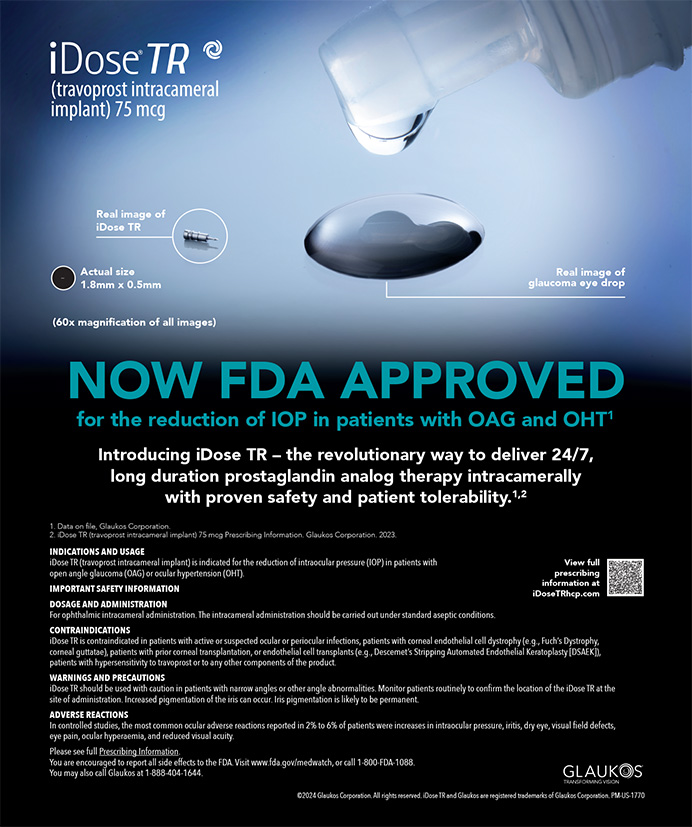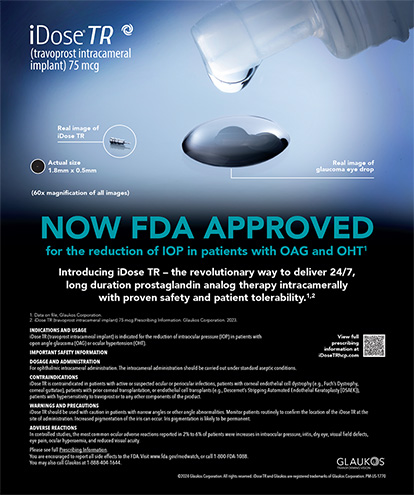This report entails initial results of both the US and Canadian arms of the FDA clinical trials examining customized LASIK correction of ocular aberrations. We are using the Alcon (Fort Worth, TX) Summit Autonomous LADARVision® platform in CustomCornea® mode, employing a wavefront-guided ablation. The US arm of the study, under Marguerite B. McDonald, MD, began in October 1999. The international arm began in late November 2000 at the University of Waterloo in Canada.
ALGORITHMS AND NOMOGRAMS
The algorithm refers to the software mathematics that convert the wavefront measurement into an ablation profile. As a part of CustomCornea®, Alcon has developed a single algorithm to perform this task. The same algorithm is applied to all types of correction, whether they are myopic, hyperopic, or for mixed astigmatism. A nomogram is an empirical adjustment that is applied to a clinical measurement before calculating the ablative treatment using the algorithm. Typically, this is done to counter trends in previous outcomes. Nomograms are often site-specific, to account for unique factors such as environmental conditions, or are surgeon-specific in order to compensate for variations in surgeon technique. We have made no nomogram adjustments in this trial. The measured wavefront for every patient in our study was entered directly, using only the algorithm to calculate the ablative treatment.
STUDY DESIGN
The US arm of the study used a contralateral design to provide a control eye by which to measure improvement over conventional treatment. We also used a population with a high chance of obtaining a satisfactory result with conventional treatment, as these individuals needed to have a close match between photopter and wavefront refractions and have very good preoperative best-corrected visual acuity (BCVA).The results in this presentation reflect the long-term postoperative data available for eyes treated with the refined custom algorithm.
CUSTOM TREATMENT VS. CONVENTIONAL
Uncorrected visual acuity achieved with the custom treated eye versus conventional treatment was superior. A UCVA of 20/20 or better was 20% higher in the custom treated eyes in the US results than in the conventionally treated eyes. We believe these results can be improved by modifications to the nomogram to account for each surgeon's technique and site parameters. There was an increase in the percentage of eyes with BCVA of 20/12.5 or better from 10% preoperatively to 30% postoperatively.
In the conventionally treated eye, there was a significant increase in spherical aberration that is typical with laser systems and current treatments today. In comparison, in the custom treated eye, there was almost no change in spherical aberration from the preoperative condition. This is an improvement over current treatments and shows why all patients can benefit from a custom procedure (ie, no induction of spherical aberration). In the custom treated eye, there was only a slight increase in coma from the preoperative condition. Note that with trefoil, the induction of this high-order aberration is much greater with conventional treatment than with custom treatment.
In the conventionally treated eyes, we found a 61% increase in the higher-order RMS error. Although any increase is not desirable, this value compares favorably with analogous measurements reported for other laser devices. The aberration increase in the custom treated eyes was three times less, only 21%.
INTERNATIONAL ARM STUDY RESULTS
The BSCVA of all eyes had to be at least 20/25 in order to qualify for this study. We used a population with a very good preoperative BSCVA so that the patients had a high chance of obtaining a suitable result, even with conventional treatment. Our study results showed that 96% of myopes saw 20/25 or better uncorrected, 82% saw 20/20 or better, 61% saw 20/16 or better, and 25% saw 20/12.5 or better. The results of the hyperopic patients showed that 88% saw 20/25 or better, 63% saw 20/20 or better, and 25% saw 20/16 or better.
EXAMPLES
The first patient had a myopic treatment of about 3 D. Figure 1A and B shows the typical concave wavefront for a myope preoperatively, and the 1-month postoperative wavefront over a 5-mm pupil. The postoperative wavefront is essentially flat, indicating excellent correction of the aberrations in this eye. The total wavefront RMS error after surgery was 0.16 µm, which was essentially the same as the preoperative level for the higher-order aberrations alone. Clinically, this patient was still complaining of some dryness at 1 month, but despite this had a UCVA of 20/20 under our mesopic test conditions, and we expect further improvement with resolution of the dry eye symptoms.
The second example shows a hyperopic correction of about 3 D (Figure 2A and B). The postoperative wavefront, while generally much flatter than the preoperative wavefront, contains a slight cylindrical profile, indicating a residual astigmatic error. With spectacle correction of the residual cylinder, the mesopic BCVA improved to 20/16.
SUMMARY
In conventional LASIK treatments, all higher-order aberrations are increased. For the first time, there was a significant decrease in spherical aberration in wavefront-treated eyes. Coma was increased in this cohort and trefoil was approximately the same as it was preoperatively. We have shown that coma can be induced by the LASIK hinge, and this may be one explanation for the fact that coma is still seen. In the future, we would like to modify the algorithm to account for the hinge effect if it can be accurately quantified.


